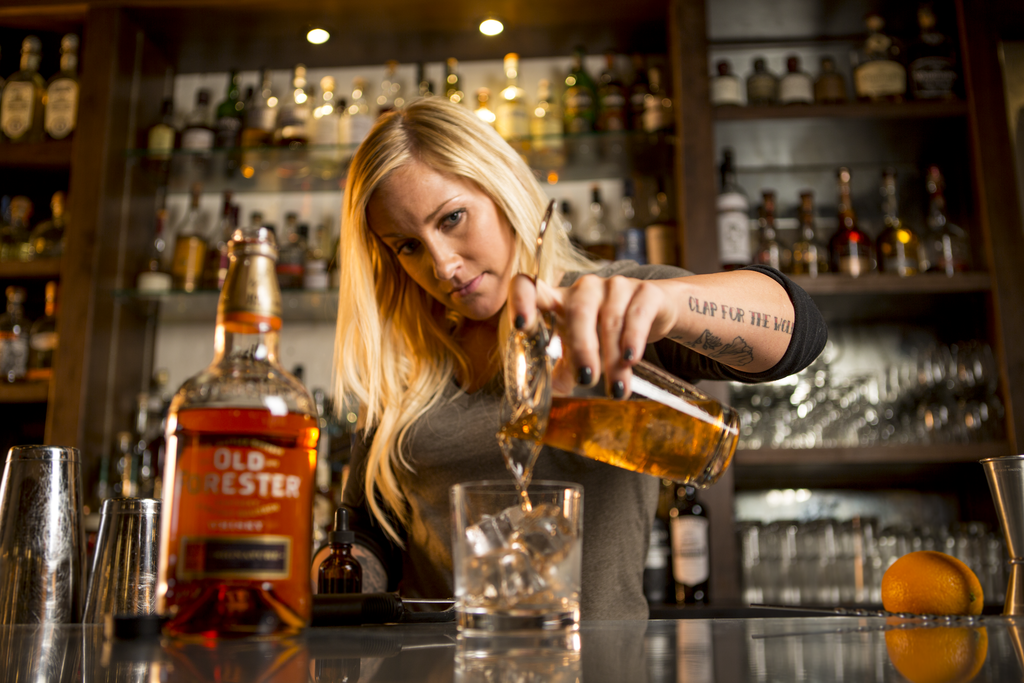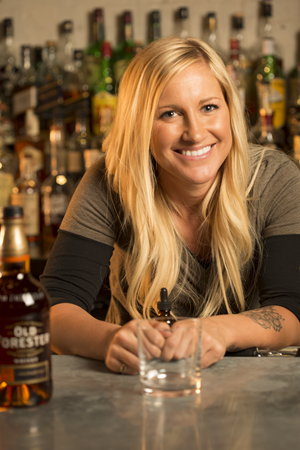Old Forester's Jackie Zykan Serves Up Whiskey Wisdom Ahead of Repeal Day
Nov. 16, 2016

Jackie Zykan has what many would consider to be a dream job. She is Old Forester’s Master Bourbon Specialist, a role that has her traveling the country spreading the good word of Old Forester to anyone willing to belly up to her bar and listen.
So what does a Master Bourbon Specialist do?
When asked what her typical day looks like, Zykan laughs it off with a sarcastic “Ha!” and yet, immediately proceeds to share stories of her daily, weekly and monthly journeys towards building better bourbon understanding. Her passion for whiskey is immediately noticeable, as she’s able to percolate off technical details as if they are simply common knowledge. Her familiarity of the Old Forester brand is–as expected–impeccable, and the way she weaves facts, figures, and dates into her historic tales makes a common timeline sound more like a movie plot. This includes stories of how the Brown family kept the Old Forester brand alive by being one of the 10 lucky distilleries to receive a license to sell alcohol during the dark era known as Prohibition. In fact, Old Forester is the only bourbon continuously distilled by the same company before, during, and after Prohibition.
Now, Old Forester has served up its newest addition to their lineup and the third installment of the brand’s Whiskey Row Series: 1920 Prohibition Style Whiskey. We caught up with Zykan back in September, the morning after she unveiled Old Forester 1920 in Louisville to a packed crowd at the Frazier History Museum.
Breakthru: How was the event at the Frazier History Museum?
Jackie: It was great! This is the first time anyone has even cracked open a bottle of Old Forester 1920. We had to rush a case through the distributor just to get it to the event on time.
This is the third event we’ve done at the Frazier History Museum and it’s always this speakeasy-ish party because of Old Forester’s history of being present all through Prohibition.
Speaking of prohibition: Can you give me a little bit of background about the new Old Forester 1920 Prohibition Style Whiskey?
The new 1920 is a blend of whiskeys from a very small selection of barrels. All the Whiskey Row whiskeys made are from about 21 barrels selected for a specific flavor profile that we want to go for. It’s not like the 86 and 100 proof signature which is 200 barrels at a time.
It’s an intense juice, I’m not going to lie. The whiskey has a lot of flavor going on. I mean, obviously at 115 proof there’s a lot of alcohol there, but it is balanced outvery well. All of the flavors just meld perfectly at that point proof.
Why did Old Forester decided to bottle it at 115 proof? That number seems a bit random.
It seems very random. During Prohibition, if you had access to a prescription for whiskey, you would have got bonded whiskey. So bottled and bonded whiskey is always 100 proof, but if you had a friend at Brown-Forman you could get the insider sip, which is straight out of the barrel.
At that time, straight out of the barrel whiskey would have been about 115 proof. We have archival notes reporting this number. Today, when we think barrel proof, we think in the 130s to 150s–so why is it so low? Well, back then, whiskey actually went into the barrel at a lower proof. This is before there were actual rules and regulations about bourbon as we know them today. Sure, we were on the market at that time as medicinal 100-proof-bonded Old Forester, but if you knew somebody and could get the inside juice, it would’ve been the barrel strength 115 proof.
Old Forester was one of the few distilleries that operated throughout Prohibition, correct?
Yes, so there were 10 total. We had permit number three. It was a fascinating time. We’ve always been here. I think the juice is just so good that it lasted. That’s the way I always think about it.
Are the barrels for 1920 being pulled from any specific part of the warehouse or is it comprised of a selection of barrels from throughout the building?
It’s really a very specific selection of barrels based on flavor, as opposed to location.
Our warehouse is heat cycled and has concrete dividers in between every six racks or so, except for some that go every three. Inside it is pretty consistent temperature-wise, so we don’t have those temperature fluctuations where it is hot at the top and cool at the bottom.
So when there is a lot of bourbon ready, our Master Distiller Chris Morris will go through and have samples pulled, taste them and then select which barrels should go into which whiskey.
Can you talk a little bit more about your warehouse? It’s pretty unique that the temperature can be controlled as much as it can.
In Kentucky, it gets pretty toasty in the warehouse during the summer, so we just kind of let the barrels hang out all natural. During the winter, however, that’s when we really start to, I don’t want to use the word–force-maturation, but it’s kind of forced. Once it gets down to about the mid-60s Fahrenheit inside, they crank on the heat and when temperature gets into about the mid-90s Fahrenheit they turn it off. By doing that you get this tea bag effect where the temperature dips up and down, up and down, as opposed to just letting it hold still all winter long. By doing that you’re replicating seasonal cycling all throughout the winter time. This is an old practice; it’s not something new. This is something everyone used to do but now it’s just a matter of whether or not they wanted to maintain the cost. It’s an expensive process to heat cycle.
 Tell us about the new distillery that’s being built in Louisville’s historic Whiskey Row. It’s supposed to include a barrel house, correct?
Tell us about the new distillery that’s being built in Louisville’s historic Whiskey Row. It’s supposed to include a barrel house, correct?
Yes.We’ll be able to store about 1,000 barrels on Whiskey Row in the new distillery that will be open at the end of 2017. We need the extra parking space for the barrels. We’re at our max production and with that distillery full load running we’re going to need even more space to hold the stuff. We’re either going to have to start selling a lot of single barrels or we’re going to have to build more warehouses.
You’ve got to be excited about the new Whiskey Row distillery opening because now it gives people a chance to experience Old Forester in the place it is actually being created.
I know! We’re sort of the Willy Wonka distillery of the industry right now. We don’t have a visitor center. So we don’t have this tour extravaganza thing. With the new Whiskey Row Distillery opening, people will finally see the process and how this awesome whiskey is actually made.
What new opportunities are you particularly excited about in the new distillery space?
I’m so excited about this distillery opening because on the second floor where the tasting rooms are, there’s a separate area that’s an actual research bar so I don’t have to keep making cocktails out of a cube anymore. That is going to be awesome. I’m really hoping we can expand our single-barrel program with that research bar.
Plus, we’re launching a whole slew of things like VIP tours where you get to come up and learn techniques. We can also have events there. It’s just a really great space that I have yet to see in another distillery that actually offers a full process start to finish. You’ll be able to see everything there. Complete transparency.
I’ve heard you say before that Old Forester is an urban bourbon brand. What do you mean by that?
In my mind, Old Forester is a true product of this American industrialist family, the Brown family. Old Forester was the brand that started the entire Brown-Forman company, and throughout its lifespan it has been made right here in Louisville, Kentucky. Production, storage, bottling–everything. That’s where we get this urban bourbon thing from. It’s not made out in the woods. There was no one on a wooden raft. It’s always been an American industrialist brand. It’s the vision of a man, an entrepreneur. He had the support behind him and he stuck with it and had the drive. I think that sort of encompasses the American dream that a small business owner goes with. It just so happened to take off into a very large business.
What advice would you give to some of our people? How would you suggest they approach accounts with Old Forester?
When you’re going into these accounts, there are many questions. What’s this going to be used for? Is it going to be in the rail? Is it going to be in a cocktail? Is there a cocktail on the list that tastes better with it? My best advice is to have the bartender, bar manager or whoever is making the decision about that recipe, just have them taste it. Have them make it with Old Forester, whichever one has a proof similar to the one they’re already using. Have them make both and put them side-by-side. The one with Old Forester is going to taste better. It just is. It just stands up more because it is so balanced from the start. It’s just a really great whiskey. That’s the guiding light for people.